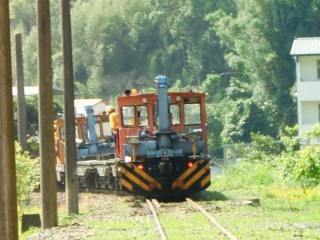The plan was ambitious, but feasible. I was going to catch the 9:05am bus from Aso Station 阿蘇駅, get off at Kusasenri-ga-hama 草千里ヶ浜, hike to the top of Kijima-dake 杵島岳, walk from there to the Aso-san Ropeway 阿蘇山ロープウェイ and ride it to the top, walk up to Naka-dake 中岳 and look at the active volcanic crater, hike from there a couple of hours to the Sensui-kyō Ropeway 仙酔峡ロープウェイ and take that to the bottom, walk all the way down to Miyaji Station 宮地駅, and then take a train back to Aso in time to have dinner, and possibly, a bath at the Yume-no-yu 夢の湯 onsen. This was a hike that promised both an up-close encounter with an active volcano, and stunning views across the world's largest caldera.
Mother Nature, however, had other plans. It rained, and the wind blew hard, all night. While things had cleared up somewhat when I woke up around 7, the mountains could not be seen. I caught the first bus to Aso-san 阿蘇山, but it wasn't long before our vehicle was swallowed up by the fog and low-lying clouds. According to my guidebook, I was to get off at Kusasenri and look for the start of the hiking trail at the far end of the parking lot. However, I couldn't even see where that was after stepping off the bus. The trail eventually emerged out of the mist, only to be roped off and closed to walkers!
I didn't come this far to be denied, however, so I simply hopped over the fence, and commenced the hike. I soon found out why the trail was closed, for it was not only foggy, but extremely windy! I struggled up the path leading to the top of Kijima-dake, but had to give up as I could barely move forward in the face of the gusts. I then attempted to take the upper route to the ropeway, but encountered the same difficulties, with the howling wind making progress extremely slow and difficult. Turning back, I found a lower path to the ropeway, and this one turned out to be easier, relatively speaking. I had to climb over a couple more roped-off gates along the way, but in the end I did make it to the ropeway station. Despite the harshness of the weather conditions, the walk was beautiful in its own stark way:
Proof that I was at least on Aso-san, even if I couldn't see much of it. The photo on the right was taken in front of the ropeway building - notice how I'm having to hold on to my Los Angeles Angels cap to keep it from blowing away:
To no surprise at all, the ropeway to Naka-dake was closed, and was the road. I considered continuing on up via the walking trail, but two things prevented me from doing so: one was the long rope tied across, with the large "No Entrance" sign hanging from it; and the other was the fact that the path could be clearly seen from the ropeway building, and my red jacket would have offered no camouflage whatsoever. Besides, the idea of getting blown over the edge and into the crater was very unappealing, and so I caught the bus for the short ride back down to Kusasanri. For lunch, I had a bowl of beef soba 牛肉そば, though in retrospect I wish I'd had to courage to order the horsemeat soba 馬肉そば that was also on the menu! Instead of seeing a volcano, I had to content myself with going into the Aso Volcano Museum 阿蘇火山博物館. Here, at least, I could look into the fog-covered crater via a real-time video camera feed (I was even able to direct the camera!). After about five hours on the still fog-shrouded mountain, I caught a bus back down to the town of Aso, and wondered what to do with the rest of the afternoon.
What I ended up doing was to take a nice walk in the occasional sunshine (no break in the cloud cover on the mountain, however). After taking a look at Saigenden-ji Temple, which dates from 726 (see photo below), I came across a sign indicating a route called the "Denen Yutatto Sampo-michi" 田園ゆたっと散歩道. With nothing better to do, I followed the arrows, and was rewarded with a pleasant stroll through old neighborhoods with traditional houses, past old Shintō 神道 shrines and cultivated fields (not to mention several cows, a common sight in central Kyūshū but a rare one in most other parts of Japan) before ending up on the main road, Highway 57. Awaiting me there was a kaitenzushi 回転寿司 called Sushi Ichiba 寿司市場, where I rewarded myself for making the best of a disappointing day:
A final note about my accommodation, Minshuku Aso-no-Fumoto 民宿阿蘇のふもと. Things were pretty basic, no bath or meals, just a room and a shower, for ¥4200 ($46/NT1471) a night. The owner was nice, however, and in addition to providing pick-up to and from the train station (though it was only a ten-minute walk away), she provided me with a bus schedule, and drew a detailed map of all the dining options in the area. She was used to dealing with foreigners, which came as no surprise because Aso was crawling with 外人 during the two days I was there. Japan's domestic tourism industry is facing a slowdown as social conditions change, but foreigners seem to be taking up the slack. The local tourism authorities have responded by making things accessible to non-Japanese speaking visitors, with plenty of English-language information available. Though I didn't really need it myself, I appreciated the efforts, especially when tourism officials here in Taiwan seem content to become dependent on visitors from China.






































